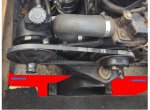Hi Folks, a newbie here.
I read every possible thread and youtube videos I could before posting my question here. It seems there isn't a straight answer for it, but many "it depends".
I just bought an As-Is 17-footer (1990 bowrider, I/O 3.0 GM 4Cyl 140 Alpha One, Engine is 1986, I think) without water testing it. Not even on the mufflers. I did it intentionally as the price justified it. The boat came with a good shape trailer, so just selling the trailer would recover what I paid for it.
I did turn the engine to verify it wasn't seized. The engine oil seemed fine, same for the outdrive lube. Spark plugs looked great (rust inside the ceramic insulator, suggesting condensation).
Got it running on the muffles at home to notice there was a 7-inch crack on the block right under the exhaust manifold - port side. I'm sure the boat wasn't winterized by the previous owner. Since I bought it for fun and didn't want to spend much on it, I JB welded the block. Went out to test it in the water. The boat runs awesome! The engine fires up on the spot; runs smoothly and feels powerful. It revs up beautifully. Consistent oil pressure and temperature. It planes quickly.
When I came back to the dock, I rechecked the oil and noticed the dreaded milky oil. I looked at the filler cap, no milky oil there. There is no smoke or high temp, but I suspect the block is cracked inside. The sparks are clean, and there is no water or fuel in the cylinders.
I really like how the boat rides; I wouldn't want to get rid of it. Other than the pressure test (planning to do it this week), is there any other way to rule out a cracked block without taking the engine apart?
It would be a shame if it's cracked, it's such a cool boat. I won't lose any money but would hate to sell it.
Leaving you a video here so you can hear the engine
Thanks for the help.
I read every possible thread and youtube videos I could before posting my question here. It seems there isn't a straight answer for it, but many "it depends".
I just bought an As-Is 17-footer (1990 bowrider, I/O 3.0 GM 4Cyl 140 Alpha One, Engine is 1986, I think) without water testing it. Not even on the mufflers. I did it intentionally as the price justified it. The boat came with a good shape trailer, so just selling the trailer would recover what I paid for it.
I did turn the engine to verify it wasn't seized. The engine oil seemed fine, same for the outdrive lube. Spark plugs looked great (rust inside the ceramic insulator, suggesting condensation).
Got it running on the muffles at home to notice there was a 7-inch crack on the block right under the exhaust manifold - port side. I'm sure the boat wasn't winterized by the previous owner. Since I bought it for fun and didn't want to spend much on it, I JB welded the block. Went out to test it in the water. The boat runs awesome! The engine fires up on the spot; runs smoothly and feels powerful. It revs up beautifully. Consistent oil pressure and temperature. It planes quickly.
When I came back to the dock, I rechecked the oil and noticed the dreaded milky oil. I looked at the filler cap, no milky oil there. There is no smoke or high temp, but I suspect the block is cracked inside. The sparks are clean, and there is no water or fuel in the cylinders.
I really like how the boat rides; I wouldn't want to get rid of it. Other than the pressure test (planning to do it this week), is there any other way to rule out a cracked block without taking the engine apart?
It would be a shame if it's cracked, it's such a cool boat. I won't lose any money but would hate to sell it.
Leaving you a video here so you can hear the engine
Thanks for the help.




















